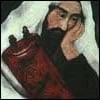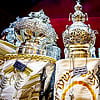I’m glad to hear that you have such strong faith in the “Hebrew Bible.” My question is, how do you know that this is true? Certainly, you must be relying on tradition. Otherwise, how do you know that the words you have before you are the original words written by Moses and the prophets? How do you know that they ever received this to begin with? What other way is there than to rely on the integrity of the Jewish people over the ages?
And that, really, is Judaism: a faith in the integrity of the Jewish experience as transmitted to us by previous generations. It turns out that everything we believe, including faith in the word of the written Torah, is based on this faith in the Jewish people. Perhaps that is the reason we call it Judaism (or Yahadut, or Yiddishkeit) and not “Torahism” (or Karaism)—because the most basic faith we have is in the Jewish people, and from there extends our faith in the written word and in the prophets.
There’s a story along these lines in the Talmud:
About two thousand years ago, there were two great sages in Israel: Shammai and Hillel. A certain gentile came to Shammai and asked, “How many Torahs do you have?”
Shammai answered, “Two. The Torah that is in writing, and the explanation of the Torah that we know by tradition.”
So the gentile answered, “About the written Torah, I believe you. About the oral Torah, I don’t believe you. Make me a Jew on condition that you will teach me the written Torah.”
Shammai responded with wrath and deprecation, chasing the man away.
So, the gentile went to Hillel. And Hillel performed the conversion. Then came time for the first lesson.
“This is an alef,” said Hillel, “and this is a bet.” And so Hillel taught the new convert the Hebrew alphabet that he would need to read the written Torah.
The next day, the man returned for his second lesson. But this time, Hillel reversed everything. “This is a bet,” he said, pointing to the alef. “And this,” he said, pointing to the bet, “is an alef.”
“Hold on a minute!” cried the convert. “Yesterday you told me the other way around!”
“And you trusted me?” said Hillel.
“Well . . .”
“So, why not trust me about the oral tradition as well?”
Hillel’s point was that without an oral tradition, there is no written Torah. Written symbols on a scroll are meaningless without context. We have no clue what the words mean, or even whether they are at all true.
The Torah says to rest on the seventh day. I once met a man who told me that he tried to keep the Sabbath as written in the Torah, but it was too hard—by four in the afternoon he just had to get up out of bed! Who says his interpretation is worth anything less than anyone else’s?
The Torah says that “these words should be totafot between your eyes.” What on earth are totafot? Where is “between your eyes”? When do you wear them, and how?
The Torah says, “You shall slaughter an animal as I have commanded you.” What was it that G‑d commanded Moses? How can we know? There seems to be no hint whatsoever in the entire Five Books of Moses. Obviously, everybody knew what Moses had been told; they did it all the time, and nobody needed it in writing.
The Torah says three times, “Don’t boil a kid in its mother’s milk.” Is it referring to a kid goat, or to a calf as well? What about a lamb? And is it only talking about boiling, or cooking with cheese too? And what about if the milk and kid are boiled separately but eaten together? And why does the Torah repeat this three times? Could it be some sort of idiom of speaking that everyone understood in those days? Who knows what their traditions and understandings were back then, and in what context they took these words?
There are many other examples, all around the same idea: The Torah is given within a certain context. Moses put the content of the Torah into writing. The context, however, we know only by tradition.
What does the context include? It includes the knowledge that an alef is an alef and a bet is a bet. It includes the meaning of the individual words, and how they are to be grouped as sentences. It includes the traditions of the Jewish people, many of which were in place long before the Torah was given, to which the Torah was simply giving G‑d’s official imprimatur. It includes explanations of the commands and stories that Moses wrote. Because when Moses taught us the word of G‑d, he explained it and elucidated it for us. But in the written form, he wrote only the bare basics.
The oral tradition also includes later decisions and exegeses made by those who led the Jewish people and were empowered to make decisions on their behalf. These are the seventy elders in every generation, as established originally by Moses himself (read all about it in Numbers 11). It is to these sages that Moses refers when he charges the Jewish people that if anything is to difficult for them to solve, they must take it to these wise leaders, and “do not turn from whatever they tell you, not to the right and not to the left” (read that one in Deuteronomy 17:8–12). Otherwise, what on earth are we supposed to do when Faraday discovers how to harness electrical power? Is it fire? If not, what is it? So, a rabbinical assembly came to the consensus that we will treat it as fire, and not turn it on or off on the Shabbat. Now all the Jewish people can keep one rule and one Torah.
These same sages were empowered to protect the Jewish people from breaking the Torah by “building fences” about the prohibitions. If you can walk right up to the edge of a serious transgression, it’s unlikely that no one is going to fall off. Which should provide an answer to your question about the boundaries for walking on Shabbat.
Are the words of the sages also Torah? How do they make their decisions? How do we know that G‑d approves of these decisions? How do we know that the interpretation we have today is correct? There are these and many more such questions. My advice is: go and learn. Adin Steinsaltz wrote a very good introductory work, The Essential Talmud, that covers many of these issues. It’s a small book, and makes good reading.
On our site, you’ll want to read Is it really the Torah, or just the rabbis? There’s also a nice series of four oral presentations on The Oral Tradition by Rabbi Lazer Gurkow, for listening to on that long commute to work.
But allow me to summarize the most crucial point: You can choose to believe in a book. Or you can choose to believe in a divine revelation. The divine revelation was encoded into a book by Moses, but its light never ceased to shine. In every generation, more and more of it enters into the world, through the medium of those sages who study the book and its surrounding traditions and all the accumulated wisdom that has unfolded over the millennia. One day, we will see how all that we unfold was contained in those original words Moses wrote. But to access it all now, make yourself part of the Jewish people, and have a little faith in us. After all, if it weren’t for us, where would that little book be?
Let me know if this helps . . . or raises more questions (questions are also part of the oral tradition) . . .
Rabbi Tzvi Freeman







Join the Discussion